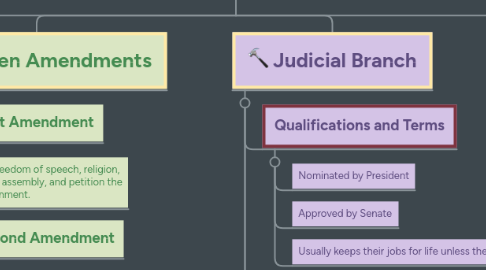
1. Legislative Branch
1.1. Congress
1.1.1. House of Representatives
1.1.1.1. -
1.1.1.2. 25 years old
1.1.1.3. Citizen in the U.S for 7 years
1.1.1.4. -
1.1.1.5. Must be a citizen in the state you represent
1.1.1.6. 435 members
1.1.1.7. Serves 2 terms
1.1.2. Senate
1.1.2.1. -
1.1.2.2. 30 years old
1.1.2.3. Citizen in the U.S for 9 years
1.1.2.3.1. -
1.1.2.4. Must be a citizen in the state you represent
1.1.2.5. 100 members
1.1.2.6. -
1.1.2.7. Serves 6 years
1.2. -
1.3. Powers
1.3.1. -
1.3.2. Creates the laws
1.3.3. Has more power than the other branches
1.3.4. Applied in Article I
1.3.4.1. -
1.3.5. Can overturn a president’s veto
1.4. Implied
1.4.1. Can create a national bank
1.5. Expresssed
1.5.1. Levy taxes
1.5.2. Borrow money
1.5.3. Coin money
1.5.4. Declare War
1.5.5. Raise and support armed forces
1.5.6. Organize the milita
2. Executive Branch
2.1. President and Vice President
2.1.1. Must be 35 years old
2.1.2. Natural Born Citizen
2.1.3. Live in the U.S for 14 years
2.1.4. A president has two terms
2.1.4.1. The 22nd Amendment limits the president to two terms
2.2. Executive Departments
2.2.1. Department of Agriculture
2.2.2. Department of Defense
2.2.3. Department of Energy
2.2.4. Department of Health and Human Services
2.2.5. Department of Housing and Urban Development
2.2.6. Department of Justice
2.2.7. Department of Interior
2.2.8. Department of Labor
2.2.9. Department of State
2.2.10. Department of Transportation
2.2.11. Department of Treasury
2.2.12. Department of Veteran Affairs
2.2.13. Department of Homeland Security
2.2.14. Department of Education
2.2.15. Department of Treasury
2.3. Powers
2.3.1. Applied by Article II
2.3.2. Can inherit powers
2.3.3. Addresses the nation
2.3.4. Enforced the laws
2.4. Roles
2.4.1. Head of State
2.4.2. Chief Executive
2.4.3. Commander in Chief
2.4.4. Chief Diplomat
2.4.5. Legislative Leader
2.4.6. Economic Planner
2.4.7. Party Leader
2.5. -
3. The Ten Amendments
3.1. The First Amendment
3.1.1. The freedom of speech, religion, press, assembly, and petition the government.
3.2. The Second Amendment
3.2.1. The right to bear arms
3.3. The Third Amendment
3.3.1. Prohibits soldiers sheltering in your house during peacetime
3.4. The Fourth Amendment
3.4.1. Prevents Unreasonable Searches
3.5. The Fifth Amendment
3.5.1. You cannot be tried without a jury
3.6. The Sixth Amendment
3.6.1. Rights of the Accused, known as the Miranda Rights
3.7. The Seventh Amendment
3.7.1. Right to a jury or bench trial
3.8. The Eighth Amendment
3.8.1. Prohibits cruel punishment
3.9. The Ninth Amendment
3.9.1. Rights of the People
3.10. The Tenth Amendment
3.10.1. Powers of the State
4. Judicial Branch
4.1. Qualifications and Terms
4.1.1. Nominated by President
4.1.2. Approved by Senate
4.1.3. Usually keeps their jobs for life unless they retire, die, or are impeached and removed.
4.2. Justices
4.2.1. There are 9 Justices
4.2.2. Head Justice is called the Chief Justice
4.3. Powers
4.3.1. Judicial Review
4.3.2. Examines laws and deems the, constitutional or unconstitutional
4.3.3. Applied by Article III
